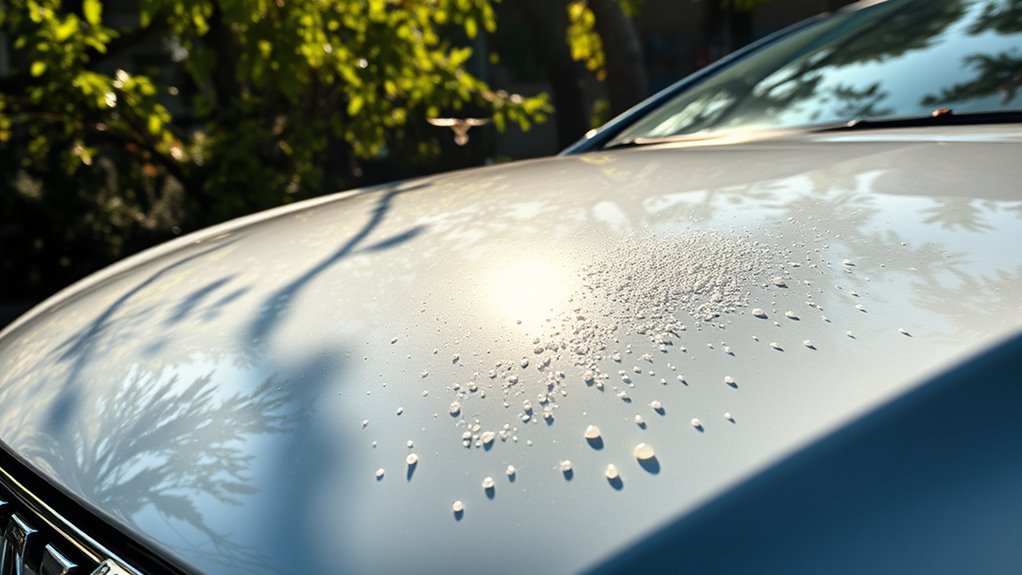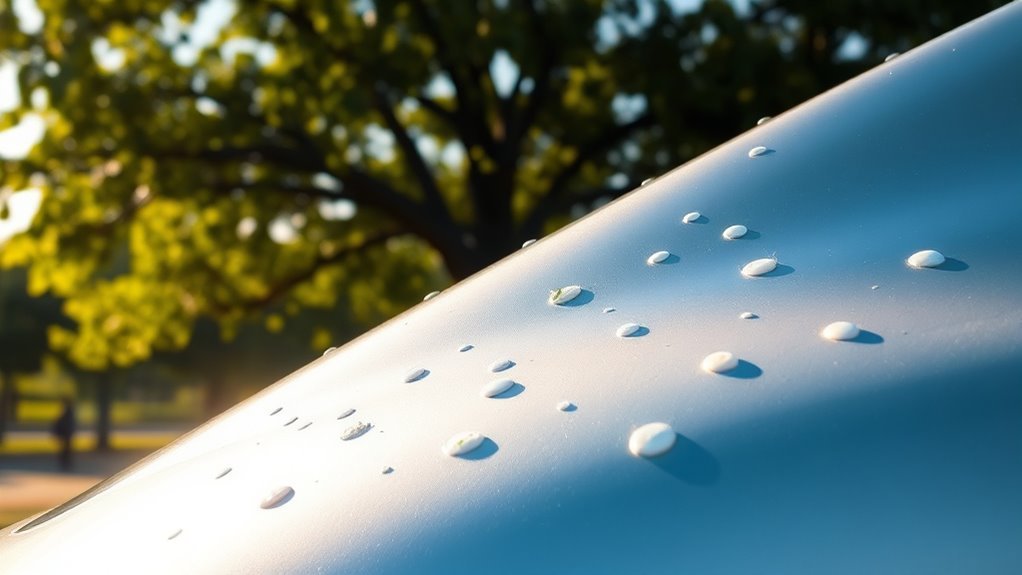Bird Poop on Your Car: What It Means
Bird poop on your car can reveal important information about local bird populations. The colors and textures of the droppings reflect the birds' diets, which can indicate the health of the ecosystem nearby. Observing these patterns can provide insights into the birds around you and their environment. What does the bird poop on your car tell you?
Key Takeaways
- Bird droppings on your car indicate the presence of local bird species in the area.
- The color of the droppings can reveal the birds' diets, reflecting local ecosystem health.
- Different droppings signify variations in bird populations influenced by habitat and food availability.
- Increased droppings during spring and summer suggest breeding activity in nearby birds.
- Persistent droppings may hint at urbanization effects, impacting bird behavior and species diversity.
Understanding Bird Droppings: Composition and Colors

When you see bird droppings on your car, you may wonder what's in that substance. Bird droppings consist of feces and urine, which gives them a wet look.
The color of the droppings can change based on what the bird eats. For example, white droppings usually mean the bird eats a lot of protein. Green ones suggest a diet rich in fruits and seeds. Dark colors might indicate that the bird has eaten insects or other small animals.
Understanding these colors can help you know more about the birds in your area and what they eat. So, the next time you find those marks on your car, remember that they tell a story about the birds nearby.
The Relationship Between Birds and Their Environment
Birds maintain a significant connection with their environment. They affect and are affected by various ecological factors. Bird behavior can change based on habitat, food, and climate. For example, shifts in bird populations can indicate changes in local ecosystems.
Birds help control insect populations, pollinate plants, and spread seeds. These actions support healthy environments. However, changes in the environment can also impact birds. Migration routes may change, and nesting patterns may adapt if habitats become unsuitable.
Observing birds reveals this vital connection, emphasizing the importance of conservation efforts to protect both bird life and the environment. Enjoy watching birds, as they illustrate the balance within nature.
Bird Poop as a Sign of Local Ecosystem Health

Bird droppings are important indicators of local ecosystem health. When you see bird poop on your car, it means more than just a mess; it shows the variety of bird species in your area. A wide range of bird species usually indicates a healthy ecosystem.
However, fewer birds can mean environmental problems or loss of habitat. Bird droppings provide insights into the food chain and soil quality. By examining the types and amounts of droppings, you can assess the health of local environments.
Impacts of Urbanization on Bird Population and Behavior
Urbanization impacts bird populations and their behaviors significantly. Many birds adapt to city life by changing their diets and nesting patterns. They use human-made structures for shelter and find food in scraps and increased insect populations.
However, urban areas break up habitats, making it hard for birds to keep their territories. With fewer green spaces, competition for resources increases. This leads to a decline in biodiversity, with some bird species thriving while others disappear.
Seasonal Variations in Bird Droppings

Bird droppings vary throughout the year. This change reflects bird behavior and diet linked to the seasons. In spring and summer, droppings often increase because many birds breed and consume more food to feed their young. You may see more droppings near trees and nests during these times.
In contrast, during fall and winter, many birds migrate or become less active. As a result, droppings are less frequent. The makeup of the droppings also changes.
In warmer months, birds eat more insects, altering the droppings' texture and appearance. Recognizing these seasonal patterns helps you understand local wildlife better and appreciate the natural world around you.
The Connection Between Bird Species and Their Droppings
Understanding seasonal changes in bird droppings offers insight into how different bird species affect their waste. By identifying bird species, you can observe the distinct dropping patterns they create.
For example, pigeon droppings are typically larger and more watery, often containing undigested seeds. In contrast, sparrow droppings are smaller and denser, reflecting their diet.
Recognizing these differences helps you monitor which birds visit your area and can inform you on how to minimize any impact on your vehicle. By understanding which species contribute to the mess, you can appreciate your feathered neighbors more, fostering a connection with the birds around you.
Cleaning Bird Poop: Best Practices for Car Care
To clean bird poop from your car, act quickly to avoid damage to the paint. First, gently remove any dried droppings using a plastic scraper, being careful not to scratch the surface.
Use an automotive cleaner or a simple mix of water and mild soap for cleaning. Soak a microfiber cloth in the solution and gently dab the area, avoiding hard rubbing. Rinse the spot thoroughly with water afterward.
To prevent future issues, consider applying protective coatings to your car's finish. These coatings help shield your paint from harmful substances, including bird droppings, making it easier to clean later.
Regularly maintaining your vehicle improves its appearance and helps retain its value. Enjoy taking care of your car, and it will serve you well in return!
Superstitions and Beliefs Surrounding Bird Droppings
Bird droppings are often seen as a nuisance, but they also inspire unique beliefs across cultures. Many people consider bird poop a sign of good luck. This belief comes from the idea that nature's gifts can bring wealth and prosperity. In some cultures, if bird droppings land on you or your property, it's believed to mean unexpected fortune.
On the other hand, some view bird droppings as a warning sign of upcoming challenges or bad luck. These varying beliefs show our human tendency to search for meaning in everyday events.
Understanding these superstitions can connect you with those who share the same thoughts, making your experience with bird droppings less frustrating and more enlightening. Let these diverse beliefs add a layer of understanding to your encounters with birds and their droppings.
Frequently Asked Questions
Does Bird Poop Damage Car Paint Over Time?
Yes, bird poop can damage car paint if it is not cleaned off quickly. The acids in bird droppings can eat away at the paint, leading to discoloration and damage. To protect your car's appearance and value, wash off bird droppings as soon as possible. Regular car maintenance and paint protection can help reduce any potential harm. Keep your car looking good by staying on top of these issues.
Are Certain Birds More Likely to Poop on Cars?
Certain bird species, such as pigeons and seagulls, often poop on cars. To avoid this issue, park in covered areas or use car covers. These methods can help prevent birds from marking your vehicle.
How Often Should I Clean Bird Droppings off My Car?
You should clean bird droppings off your car immediately. Regular cleaning is important for maintaining your vehicle. Keeping your car clean improves its look and protects the paint.
Can Bird Poop Indicate an Abundance of Certain Food Sources?
Bird droppings can show where food is plentiful. If you see more droppings in an area, watch the birds' actions. This may mean they have enough food, which signals a healthy environment.
What Should I Do if I'm Allergic to Bird Droppings?
If you are allergic to bird droppings, closely monitor your allergy symptoms. Use prevention methods to reduce exposure. Wear masks when outside. Keep your living spaces clean. Avoid any contact with bird droppings. These steps can help you maintain your health and safety in shared environments.

Hello, I’m Emily Price, the founder of Birds Affection. As a passionate bird enthusiast and spiritual seeker, I’ve always been fascinated by the symbolic meanings and mystical connections between birds and our lives. On this website, I share my knowledge and insights on the spiritual significance of various bird species, exploring their roles as messengers, guides, and teachers. Through my writing, I aim to inspire and educate others on the profound wisdom and beauty that birds bring to our world. Join me on this journey as we delve into the enchanting realm of bird symbolism and discover the hidden meanings behind these magnificent creatures.







